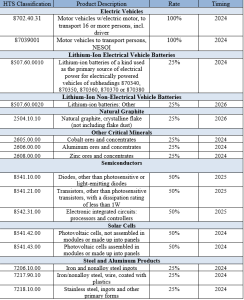Search
Published on:
USTR Calls for Stakeholder Comments Following the Report on the Four-Year Review of the Section 301 Tariffs
On May 14, 2024, the U.S. Trade Representative (USTR) published the Four-Year Review of Actions Taken in the Section 301 Investigation (“Report”), which addresses the four-year review of China-related tariffs under Section 301 of the Trade Act of 1974, as amended (“Trade Act”) (19 U.S.C. 2411). Our previous alert on this report is available here.
On May 22, 2024, USTR published a Federal Register notice which requests comments on the proposed modifications and machinery exclusion process discussed in the May 14 report. The notice does not address the status of the current exclusions from the Section 301 duties, which are due to expire at the end of May.
Below, we discuss the proposed modifications detailed in the USTR Federal Register notice.
Background
Pursuant to Section 307(c)(3) of the Trade Act (19 U.S.C. 2417(c)(3)), USTR, in consultation with the Section 301 Committee, conducted a comprehensive review of the actions taken on July 6, 2018, and August 23, 2018, regarding China’s technology transfer, intellectual property, and innovation practices. The findings were published in the Report and detailed in our prior alert.
Based on the findings of the Report, USTR recommended maintaining the Section 301 tariffs and enhancing their effectiveness by adding or increasing tariffs on specific strategic products. Following these recommendations, on May 14, 2024, President Biden directed the Trade Representative to maintain the current tariffs and to increase tariffs on certain specified products from China. President Biden also established a process for temporarily excluding certain machinery used in domestic manufacturing from the tariffs, prioritizing solar manufacturing equipment.
Proposed Tariff Increases
In Annex A to the Federal Register notice, USTR listed 382 tariff classification subheadings and five statistical reporting numbers, representing an approximate annual trade value of $18 billion (2023). President Biden has mandated that tariff increases for certain products take effect in 2024, 2025 and 2026. USTR proposed that the increases in 2024 become effective on August 1, 2024, and those in 2025 and 2026 take effect on January 1 of the respective year.
Notable Harmonized Tariff Schedule (HTS) classifications included in Annex A include the following:
Proposed Exclusion Process and Temporary Exclusions
USTR stated that in addition to the proposed tariff modifications, there will be an exclusion process allowing interested parties to request temporary exclusions for certain types of machinery used in domestic manufacturing, classified under specified subheadings in Chapters 84 and 85 of the HTSUS. Eligible subheadings for temporary exclusion are detailed in Annex B of the Federal Register notice. Procedures for requesting exclusions will be published separately, with granted exclusions effective through May 31, 2025.
Additionally, to bolster domestic production and reduce dependence on China in the solar sector, USTR proposes 19 temporary exclusions for solar manufacturing equipment, as outlined in Annex C of the Federal Register notice, effective immediately and through May 31, 2025.
Request for Comments
Importantly, USTR requested comments from interested stakeholders by June 28, 2024.
USTR specifically welcomed written comments on its proposed modifications to increase section 301 tariffs on certain Chinese products listed in Annex A, focusing on their effectiveness against China’s practices related to technology transfer, intellectual property, and innovation, and their impact on the U.S. economy and consumers.
Specific feedback was also requested on the scope for ship-to-shore cranes, higher tariff rates for medical supplies, and additional reporting codes for facemasks. USTR is also inviting input on the machinery exclusion process outlined in Annex B, querying whether the listed subheadings should be eligible and if any relevant subheadings have been omitted. Finally, comments are requested by USTR on the proposed solar manufacturing machinery exclusions in Annex C, including any suggested changes to the product descriptions.
Specific procedures for submitting written comments to USTR are available in the Federal Register notice.
RELATED ARTICLES
USTR Issues Long-Awaited Report on the Four-Year Review of the Section 301 Tariffs
 Global Trade & Sanctions Law
Global Trade & Sanctions Law


